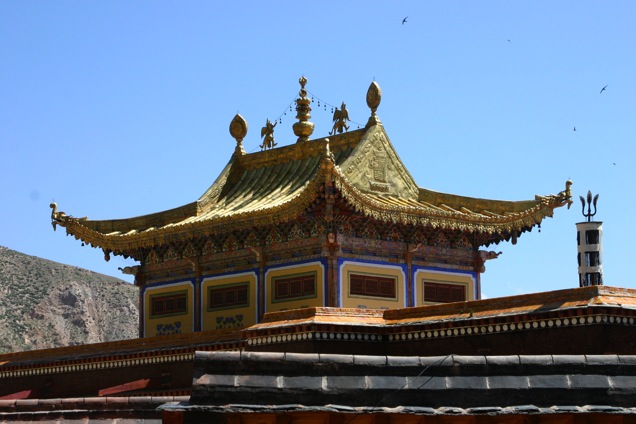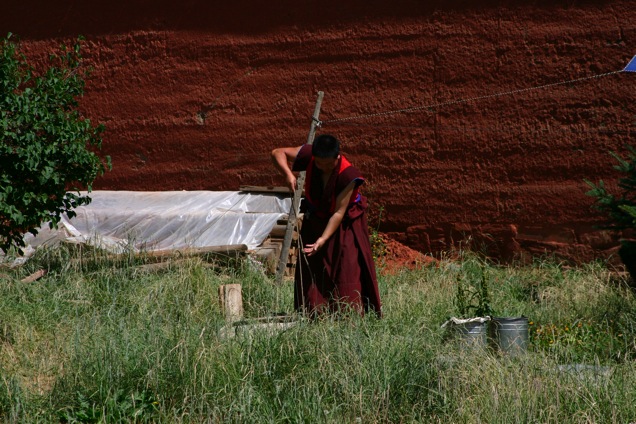


Xiahe

18 August: Labrang Monastery
Breathtaking encounter with Buddhist culture today. We took a guided tour (with a monk) through Labrang monastery, the biggest buddhist monastery outside Tibet.
The monastery is surrounded by a “Pilgrim’s Route” (kora).
The kora is flanked by hundreds of prayer wheels. We gave up after the first hundred, but the locals turned out to be quite proficient in turning them and keeping up a good pace, faster than us, so our only excuse was that we had to get used to the altitude (2900 meters). 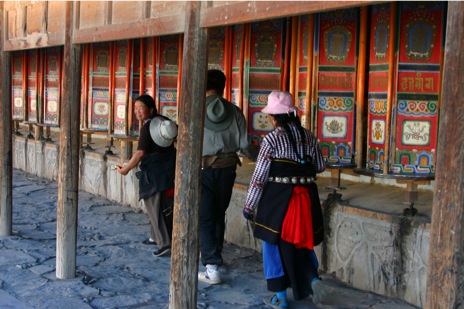

The monastery is a city in itself that’s overflowing with activity. Some of the low buildings are very simple, most are beautifully painted in a shade of red clay (maroon?). The buildings intended for religious worship are more spectacular, often painted with bright ornaments. The color blue is especially remarkable here - a string lapislazuli. The roofs are decorated with gold: 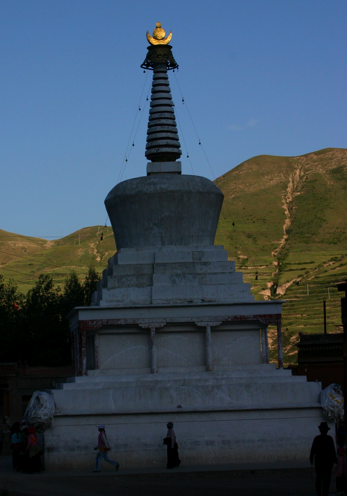 One stupa is completely golden, another one carries a gold piece on top, an orb resting inside a moon. Although these buildings are extremely beautiful, they are clearly intended for being used on a daily basis - they lack the sterile beauty of European churches (that almost no-one visits except on a Sunday service, and even those are often a very small affair).
One stupa is completely golden, another one carries a gold piece on top, an orb resting inside a moon. Although these buildings are extremely beautiful, they are clearly intended for being used on a daily basis - they lack the sterile beauty of European churches (that almost no-one visits except on a Sunday service, and even those are often a very small affair).
 One stupa is completely golden, another one carries a gold piece on top, an orb resting inside a moon. Although these buildings are extremely beautiful, they are clearly intended for being used on a daily basis - they lack the sterile beauty of European churches (that almost no-one visits except on a Sunday service, and even those are often a very small affair).
One stupa is completely golden, another one carries a gold piece on top, an orb resting inside a moon. Although these buildings are extremely beautiful, they are clearly intended for being used on a daily basis - they lack the sterile beauty of European churches (that almost no-one visits except on a Sunday service, and even those are often a very small affair). Many monks are walking around, the place is clearly alive.
We notice a pleasant, spicy scent. This is a sort of cranberry wood that is burned as a sacrificial offering in small unconspicuous ovens that are strewn over the monastery complex.
I should mention that, even though the monastery is clearly separated from Xiahe architecturally, the monks are by no means limited to its confines. On the contrary, many of them can be seen walking though the city, usually carrying bags with groceries. Some of the monks are still young boys, others are young men, and some are old. All look very beautiful in their dark red robes. The robes look worn - not dirty, but a bit dusty at times, and made of robust material. A fraction of monks goes about daily chores, while the older, wiser (etc.) monks meditate.
Although I can never shake the feeling of intruding when I’m in a foreign country, the easygoing atmosphere in the monastery that seems to absorb our small group makes me feel welcome.
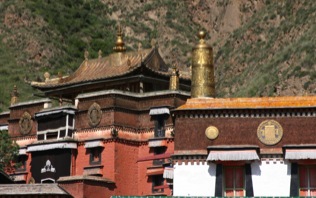
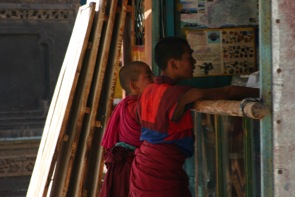
Labrang made me think about how different it was from the Forbidden City. Each of them is a little City in itself and has many buildings of religious significance and leaves you in awe of the amount of work put into it. But the big difference is that the Forbidden City is dead. It is inhabited by tourists and sweepers, and its empty halls only make you wonder what life had been. Labrang on the other hand is full of life, with monks walking everywhere, pilgrims going on the pilgrim’s route, young monks making mischief with each other. The most impressive scene we saw during the tour we took: In a huge prayer hall, monks were chanting in long rows. This was such an impressive sight that I couldn’t tear my eyes away from it, though our guide was explaining the significance of the various Lama and Buddha statues.
In general, I found it more interesting to see the monks doing their things than admiring the many statues, ornaments, and books neatly stacked on shelves along the wall.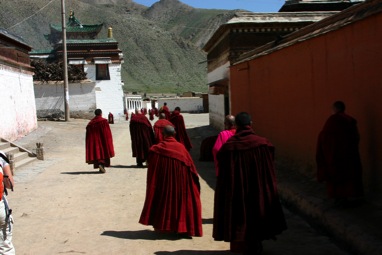

The prayer hall exerted its own magic: While I don’t hold with many Westerner’s uncritical enthusiasm for Eastern religion (--> Goa escapism), I was very impressed with the beauty of the prayer chants and the monks sitting side by side. The harmonies reminded me of cicadas - deep voices leading, slowly establishing a rhythm, and gradually higher and faster harmonies merge with the first, the chants growing louder and quieting down again.
We visited several temples in the monastery. These temples have nothing in common with the conceptions a European might have based on Greek or Roman temples. We saw small, dark rooms with very high ceilings, in which enormous Buddha Statues smile down on the visitor. each temple has its own Buddha -the Buddha of the Future, the Buddha of Teaching, etc. - and at the feet of each statue, later reincarnations of that Buddh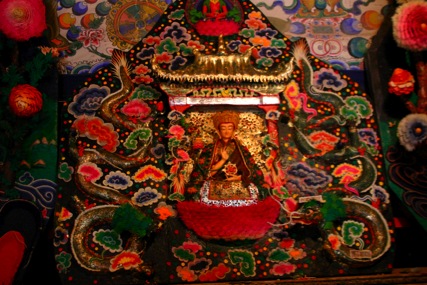 a are depicted, excepting the current Dalai Lama, of course. Often, though, the latest photo in line shows an old man grinning, who is still alive or died recently as a lama of an important monastery.
a are depicted, excepting the current Dalai Lama, of course. Often, though, the latest photo in line shows an old man grinning, who is still alive or died recently as a lama of an important monastery.
 a are depicted, excepting the current Dalai Lama, of course. Often, though, the latest photo in line shows an old man grinning, who is still alive or died recently as a lama of an important monastery.
a are depicted, excepting the current Dalai Lama, of course. Often, though, the latest photo in line shows an old man grinning, who is still alive or died recently as a lama of an important monastery.To the left and the right of the statue, we saw books piled up in fitted holes in the wall. books in buddhist monasteries have square backs and long, horizontal pages.
We also found out how monks pray in a temple: A few of them sit against the wall and chant. Some of them have food in front of them and enjoy lunch - mysterious dishes that look a bit like muesli, and small plates with yak butter, which smells extremely good. Another monk served them food out of a kettle.
At the end of the day, Steffi and I sat on the roof of the hotel, which had a fabulous view on the monastery. A perfect moment. Later in the night, we walked part of the pilgrim’s route again in complete darkness. Soon the Milky Way came out over sagittarius, quickly spanning the sky. 